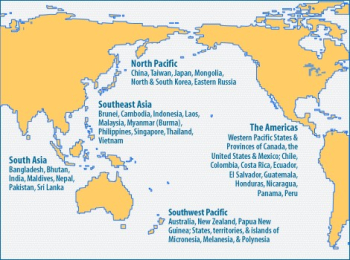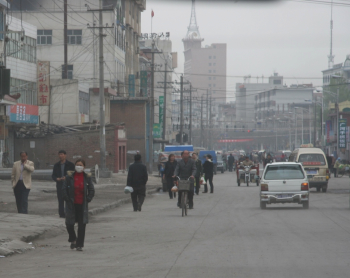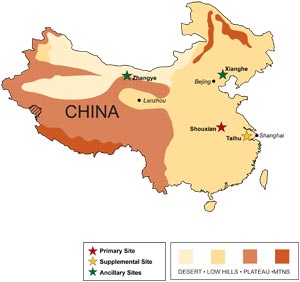A Quest for Answers About Aerosols
Data will enhance understanding of regional effects and global transport of aerosols
Contact: Lynne Roeder, ARM Public Information Officer, 509.372.4331

Aerosols are tiny airborne particles, such as dust from farming and soot from industrial plants. Aerosols in China are very dense and have diverse properties which have been observed in the atmosphere across the Pacific Rim. The atmosphere over China provides a natural testbed for studying the climatic effects of aerosols, which the Intergovernmental Panel on Climate Change identified as a high priority. Although progress is being made, continuing uncertainty is due chiefly to a lack of adequate observations.
That’s why, beginning May 19, 2008, the U.S. Department of Energy (DOE) is deploying its portable atmospheric laboratory in southeastern China, a dominant economic and industrial zone in east Asia. Sponsored by the DOE’s Atmospheric Radiation Measurement (ARM) Climate Research Facility, the ARM Mobile Facility includes a comprehensive suite of state-of-the-art instruments and data systems for acquiring essential cloud, aerosol, radiant energy, and meteorological measurements.

“Such comprehensive measurements made at a single location as those from the ARM Mobile Facility are unprecedented in China,” said Dr. Zhanqing Li, a professor in the Department of Atmospheric and Oceanic Science at the University of Maryland, and the lead scientist for the study.
Dr. Li explained that while China has a very extensive meteorological observation network, development of climate research oriented facilities did not start until recently. Shouxian—where the ARM Mobile Facility is located—is among the first climate observatory sites under development in China.
In partnership with the Institute of Atmospheric Physics, Chinese Academy of Science, the study is being conducted under the “climate science” agreement established in 1987 between the DOE and China Ministry of Science and Technology.
Putting the Pieces Together
In 2004, Dr. Li led another joint U.S.-China project that, over the course of a few years, established an aerosol monitoring network throughout China. Observations from this network, combined with preliminary analyses of multiple satellite data sets, indicated more complex and stronger effects of aerosols in China than in relatively cleaner environments.
Aerosol “direct” effects relate specifically to the reflection and absorption of energy—a pretty straightforward relationship. Aerosol “indirect effects,” on the other hand, are processes that have an impact on climate through the modification of cloud properties, like drop size, cloud life time, and precipitation.
Previous studies focused on aerosol optical properties, such as size and thickness, and their relationship to the transmission of solar energy—a direct aerosol effect. For the current study, the main goal is to “obtain a better quantitative understanding of the indirect effects of aerosols, so that climate models can do a more accurate job of simulating these effects,” said Mary Jane Bartholomew, a scientist at Brookhaven National Laboratory, and the associate site scientist for the ARM Mobile Facility.
Because the significance of the aerosol-cloud relationship was not fully realized until recently, the science in this area is still in its infancy. However, Dr. Li said there is plenty of evidence to suggest a correlation between increased aerosol production and decreased cloud cover and rain.

“Perhaps the most noticeable change to the general public [in China] is a reduction of 35 percent in visibility from the 1960s to the 1980s, as discovered by Chinese colleagues,” said Dr. Li.
At first blush, this may seem like a contradiction in terms—decreased clouds equals reduced visibility? Wouldn’t the skies be clearer? Well, no, as it turns out.
When the concentration of aerosol particles reaches a certain level, they actually create a haze layer. This not only reduces visibility, but blocks solar radiation from reaching the ground, which in turn suppresses the natural precipitation process created by heat and moisture at the surface. These factors are thought to contribute to a weakening Asian monsoon system, which is a related area of international study throughout 2008.
ARM Mobile Facility Anchors International Collaboration
To help Dr. Li in his quest to obtain more information about the link between aerosols and clouds and their affect on the Earth’s atmosphere, the ARM Mobile Facility is located in Shouxian, about 500 km west of Shanghai. An ancillary facility with a subset of the ARM Mobile Facility instruments is operating at a location in the semi-desert conditions of Zhangye, in north-central China, from April through June to measure regional differences in atmospheric properties.

The southern locations are generally warm and humid, while the northern locations typically experience hot, humid summers and cold, dry winters. These regional differences in climatic conditions and aerosol properties (optical, physical, and chemical) serve as a natural testbed for studying the dynamics of aerosol effects.
Measurements obtained by the ARM Mobile Facility and auxiliary facilities during the Study of Aerosol Indirect Effects in China will help scientists to validate satellite-based findings, understand the mechanisms of the aerosol indirect effects in the region, and examine the roles of aerosols in affecting regional climate and atmospheric circulation, with a special focus on the impact of the East Asian monsoon system.
Other organizations from China participating in the study include the China Meteorological Administration, Lanzhou University, and Nanjing University of Information Sciences and Technology. Additional supplementary sites are being operated together at the locations shown in the map.
“Hopefully, such an unprecedented U.S.-China collaboration in advanced atmospheric observation will help germinate many ARM-like facilities in China to collectively tackle the aerosol issue and other global climate change challenges,” said Dr. Li.

